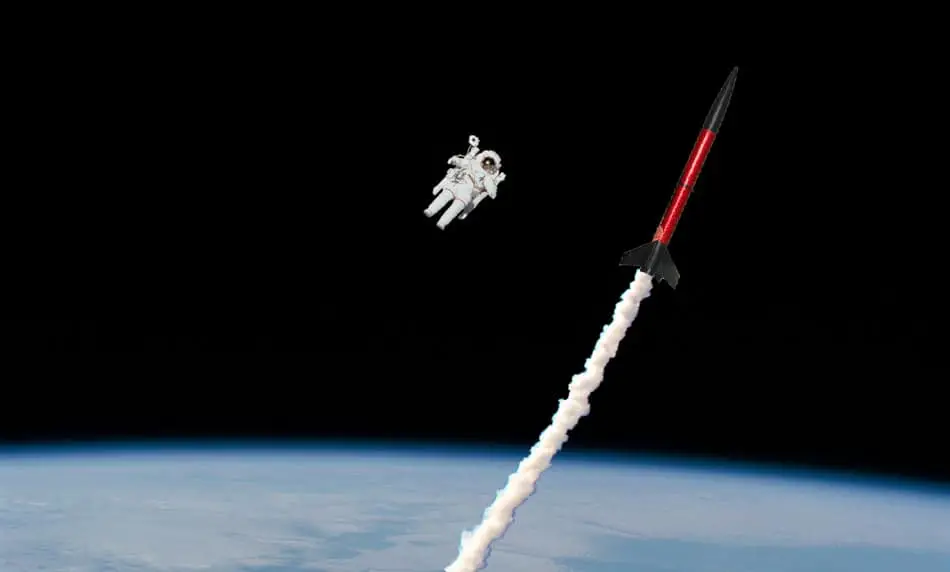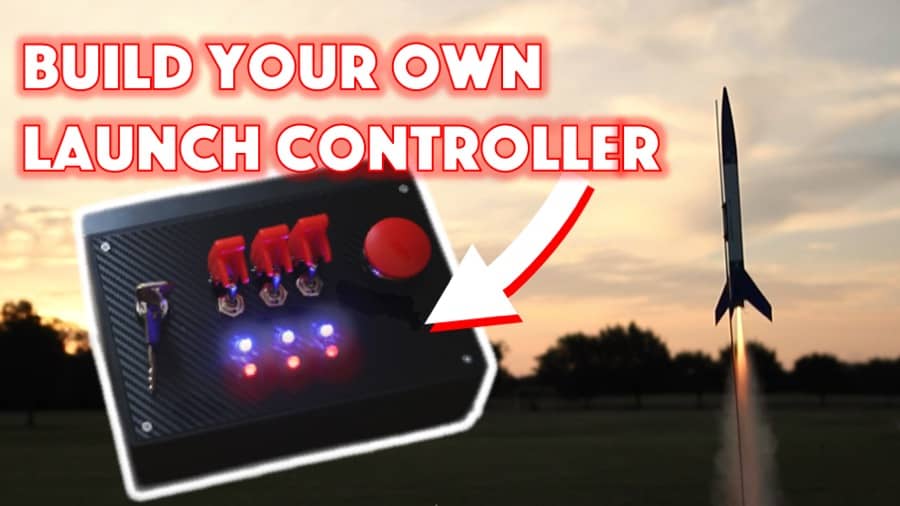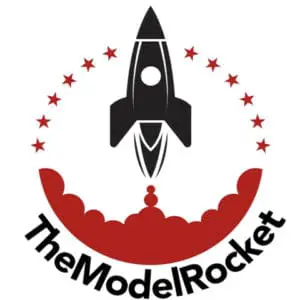
As someone interested in both rocketry and space exploration, I have often imagined what kind of rocket I could make that would actually reach space before returning back to me.
But, can model rockets reach space? If you use the official definition of model rocket that the NAR and the Federal government uses, a model rocket is not capable of reaching space. However, amateur high power rockets (which despite misconceptions aren’t technically “model rockets”) have reached space more than once.
If you’re curious about what it would take for a high powered rocket to reach space, keep reading to find out all the details of the successful space launches.
Are you still using the standard Estes controllers for your launches?
We just built our own beautiful launch controllers that make launches SO much more fun, and we documented EVERY single step and item purchased and put it into a step-by-step course that teaches you how to do the exact same thing.
Click here to learn more about how you can build your own launch controllers!

Why Your Rocket Will Probably Never Reach Space
I hate to be a Debbie downer, but the chances of any rocket you build reaching space, high powered or not, are slim to none. This amazing feat has only been accomplished by a handful of teams.
The fact is that there are a lot of obstacles that must be overcome, and it is downright expensive to get all the resources together.
Definition of a Model Rocket
As I mentioned above, there is no chance of a typical model rocket reaching space if you consider the official definition set by the Federal Aviation Administration of a model rocket. This definition of a model rocket is also used by the NAR.
Model Rocket
According to the FAA, the definition of a model rocket, what they refer to as a “Class 1 – Model Rocket,” has very distinct characteristics. It leaves virtually room for doubt or wiggle room for what constitutes a model rocket vs what constitutes a high power rocket.
Definition of a Model Rocket:
- Propellant weight: 4.4 ounces or less
- Burn Speed: slow burning
- Materials for Construction: paper, wood, or breakable plastic, no substantial metal parts
- Weight: 53 ounces or less including propellant
The only characteristic of a model rocket that is not clearly stated in this definition is the meaning of “slow burning.” I believe what they are trying to get at here is that the average thrust of the engine should not exceed 80 Newtons. Through the NAR this would classify it as a high power rocket.
A model rocket that is made of wood, paper, or breakable plastic would not be able to withstand the power required to launch the rocket into space, nor would 4.4 ounces of propellant be enough.
High Power Rockets
The FAA divides high power rockets into two categories: Class 2 High Power Rockets and Class 3 Advanced High Power Rockets. Each of these has a separate and simple definition.
Definitions of High Power Rockets:
Class 2 – High Power Rockets: A class 2 high power rocket is any rocket that does not fit the definition of a model rocket and carries an engine with a combined total impulse of 40,960 Newton-seconds or less.
Class 3 – Advanced High Power Rockets: Advanced high power rockets are all rockets that do not fit the definition of model rocket or high power rockets.
Even a class 2 high power rocket would not be able to make it to space. The rockets that have been launched into space use extremely powerful engines with total engine impulses multiple times greater than 40,960 Newton seconds.
Only an advanced high power rocket has the potential to make it to space, and getting your hands on an advanced high power rocket is difficult and even if you could, you probably wouldn’t be able to afford it.
Altitude of Space
Just how high is space exactly though? Most of us don’t think about it, but if you’re looking to launch a rocket into space, it is the first question you’re going to ask. You aren’t likely to make it into space because the altitude you must reach is high, very high.
The Kármán line is the invisible barrier between the Earth’s atmosphere and space. It is an internationally recognized as 100 kilometers, 62.1 miles, or 328,084 feet above Earth’s average sea level.
This is not just an arbitrary number that someone pulled out of thin air. (although thin air has something to do with it). 100 kilometers was chosen because it is the altitude at which the atmosphere becomes too thin for aeronautical flight.
A rocket that passes the Kármán line has entered space. This is just the very edge of space and reaching this height would not put a rocket into orbit or move it beyond the pull of Earth’s gravity. A low earth orbit would require an altitude of 2,000 kilometers or 1,200 miles (that’s over 6,000,000 feet!).
For its own purposes NASA considers space to be 50 miles above sea level, which means some of those who have launched rockets into space have done it by a wide margin.
Rocket Integrity
In order for a rocket to withstand the force of an engine that could propel it into space and then return back to Earth, it must be exceedingly well built of highly durable materials.
The rockets that are launched into space are over 14-21 feet long and made of durable, rugged metal. Even if you exclude the propellant, they are easily hundreds of pounds.
Once again, the feasibility of launching a model rocket into space depends on money. The resources involved in building such a rocket are beyond most of us.
Engine Size
The kind of engine required to launch a rocket into space is massive and incredibly dangerous. There is a reason this sort of activity requires certifications and permits.
You would need to have someone custom build the engine for a rocket that could reach space. It would likely carry over 300 pounds of composite propellant. This would be very costly, and difficult to maneuver.
FAA Permit
Launching an advanced high power rocket requires a permit from the FAA. The process of getting this permit can take well over 150 days, and it involves a lot of hard work and dedication.
This is not because the FAA doesn’t want you to launch a rocket to the edge of space, but because they want you to do it safely and not get yourself or your team hurt.
All aspects of the launch including the rocket, the engine, and the launch site must be approved.
It Takes a Team
You’ll notice that all of the rockets that have made it space or that are trying to make it to space are built and launched by teams of people over years. The logistics involved in moving hundreds of pounds of engine into place as well as moving the rocket itself alone would require a team.
Building a large rocket also takes time and skill. A team of people will often divvy up the workload. One small group could work on the recovery system while another small group works on the fins and so on.
Cost
The main reason you probably won’t be launching a rocket into space is the cost. The rocket alone will likely cost tens of thousands of dollars to build. You will likely fail a couple of times before you are successful because that is how rocketry works.
By the end of it all, you could be heavily invested in the launch of your rocket only to have it CATO seconds after becoming airborne. Most people find this reason enough to not try for a space launch.
All of the reasons I have given that you would be unlikely to get a rocket into space are impacted by your financial resources. With enough money, anything is possible.
Civilian Space eXploration Team
In 2004, the Civilian Space eXploration Team (CSXT) led by Ky Michaelson launched the first amateur rocket into space. In the past, a few businesses had been able to launch rockets into space, but it had never been documented by an amateur team.
The GO FAST rocket launched from the Black Rock Desert in Nevada, and within 10 seconds, it had reached a speed of 3,420 miles per hour. It soared past the Kármán line for 10 miles until it reached an estimated highest altitude of 72 miles.
The GO FAST rocket stood 21 feet tall with a 10 inch diameter, and it weighed a staggering 724 pounds at takeoff.
The engine on the GO FAST was classified as an S-50,150. The propellant alone weighed 435 pounds. The payload section was found nose down and feet deep in a pile of desert rocks.
In 2014 to commemorate the 10 year anniversary of the first launch, CSXT did it again. It launched another rocket even further into space, but it took some time for them to recover the rocket and all of the data as it landed about 30 miles away.
The rocket reached an altitude of 73.1 miles, and its top speed was 3,580 miles per hour. Both of these qualified the team for world records.
CSXT was also able to get the first picture taken from space onboard an amateur rocket. Here’s an onboard video of this launch:
University of Southern California Rocket Propulsion Laboratory
In April 2019, a group of 10 students from the Rocket Propulsion Laboratory of the University of Southern California became the first group of students to launch a rocket into space in a race to beat several national and international universities.
The launch took place at Spaceport America in New Mexico, an FAA approved launch site. The rocket reached an apogee of about 64 miles or 339,800 ft with an uncertainty of 16,500 ft. A close call, but it is thought to have crossed the Kármán line with a certainty of 90%, close enough for the record books.
The rocket had the potential to reach even higher altitudes, but something went wrong shortly after launch and the rocket began to oscillate slightly. Eventually it stopped and continued its flight.
It is thought that this was caused by damage to the interior of the nozzle that was found after the rocket was recovered.
The rocket was 13 feet long and 8 inches wide, considerably smaller than the GO FAST, and the motor was smaller as well, only requiring an R-class.
Despite all of this, despite every reason I have given, if your life’s passion is to launch a high power rocket into space, then I say go for it. That was one of Ky Michaelson’s life missions, and with enough dedication and support he was a leader on the team that accomplished it.
Build Your Own Launch Controller
Don’t forget! You can ditch the stock controllers and confidently build your own from scratch using our step-by-step instructions and exact materials list! We promise this will make your launch experience 10x better, and using our course License to Launch you can be 100% confident you’ll be able to finish this project and be super proud of what you’ve built! Here’s a sneak peek below.
